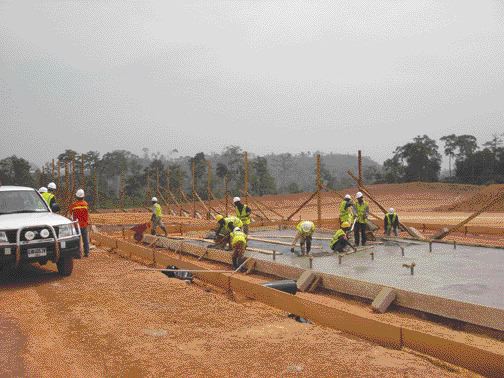Vancouver — With construction well under way, the Chirano mine is set to become Ghana’s first new gold producer of the decade. Startup is slated for August or September.
Chirano is expected to produce 123,000 oz. gold per year over a lifespan of 8.5 years (145,000 oz. annually in the first three years). The mineralization is still open at depth and along strike.
The project was awarded an environmental permit in April 2004, as well as a 15-year mining lease that covers 36.3 sq. km. “We will have the most up-to-date environmental controls in Ghana,” says Red Back President Richard Clark. “Water treatment facilities are self-contained and use European technology.”
The property encompasses a 22-km strike length of the Chirano and Bibiani shear zones.
The $61.6-million project is being funded through an arrangement with Australian-based MacQuarrie Bank (US$18.6 million in equity and US$43 million in debt).
Vancouver-based
The mine and mill at Chirano are designed to run year-round, right through the rainy season. The mill was previously used at a mine in Australia and has been refurbished. The mill was built to process 2 million tonnes per year but is expandable to 2.3-2.5 million tonnes.
Capital costs may be higher than estimated, owing to steeper commodity prices and rising fuel costs. However, the company raised an additional US$11 million late last year, which should buffer the rising costs.
The Chirano deposits have a total proven and probable reserve of 17.8 million tonnes grading 1.9 grams gold per tonne, or 1.1 million oz. The reserves are part of an overall resource of 30.4 million tonnes grading 2.1 grams in all categories. Drilling last year raised the measured and indicated figure to 28.82 million tonnes grading 2 grams gold. Another 509,000 oz. are inferred.
The company is stepping up exploration efforts to increase resources and accelerate production, and the resource estimate is being revised in accordance with the higher gold price. As part of last year’s debt-financing arrangement, Red Back has sold forward 400,000 oz. gold at US$435 per oz., whereas the feasibility study was based on US$375 per oz. Thus the company is upwardly revising its reserves at US$400, US$435 and US$450 per oz. gold.
“We’re designing the pit for higher gold prices,” says Clark. “The real economics will be run at US$435 per oz.”
Optimization studies of the pits suggest a further 8 million tonnes of the resource could be brought into reserves at present gold prices.
Chirano was first explored in the early 1990s by Placer Outokumpu Exploration. Red Back optioned the property in 1998 and subsequently acquired a 95% interest.
Chirano straddles the boundary between Sefwi volcanics to the west and sedimentary rocks of the Kumasi Basin to the east. The property is underlain by the contact between Upper and Lower Birimian rocks, consisting mainly of volcaniclastic and sedimentary rocks intruded by late-stage porphyritic granites. The depth of oxidation is around 25 metres.
Gold is hosted by an elongated granitic intrusive west of the Sefwi volcanics. The Chirano granite extends more than 10 km along strike and is 150 metres wide on average (though it reaches 600 metres in width).
The Chirano deposits are epigenetic, mesothermal style. The Chirano shear zone imposes a strong structural control. Fourteen known gold deposits occur along a single mineralized horizon.
In addition to Chirano, Red Back has 5,000 sq. km in land holdings, including the Bole and Nangodi projects, where small resources have been outlined.
Also, Red Back is near a development decision on the Farim phosphate deposit, in the West African nation of Guinea Bissau.


Be the first to comment on "Red Back fast-tracks Chirano"